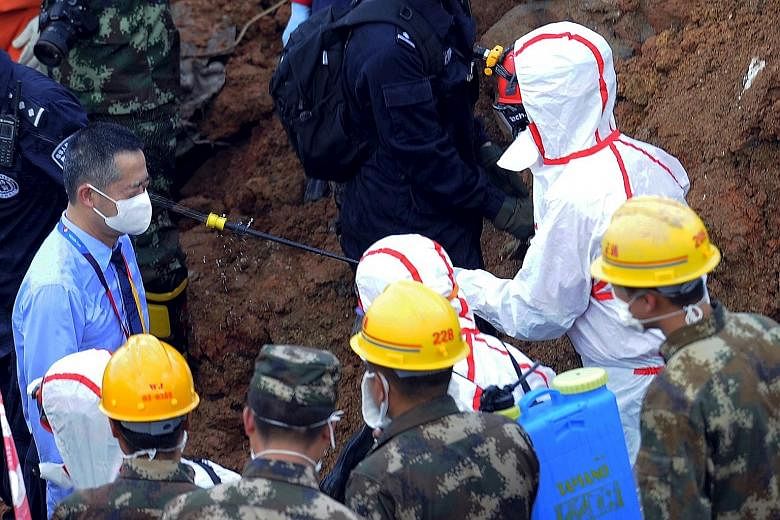SHENZHEN • When she heard the news, Ms He Daxia rushed to Shenzhen, hoping some miracle had spared the lives of 11 members of her extended family who had disappeared following a landslide caused by a collapsed mountain of building debris that left four dead.
They had left their home in central Henan in search of a new life in the prosperous southern city.
"It was a hard way to make a living, but we all have to get by and they did okay," said Ms He, who is in her 20s. She said they supported themselves by collecting and selling scrap. "They wanted to make a better life for their next generation."
Now she just wants to know what happened to them.
The story of migration, hardscrabble survival and hope for a brighter future in a city - now shattered by a calamity - is common among the casualties of the massive debris spill on Sunday morning in the Guangming New District of Shenzhen. As in a number of China's recent urban disasters, many of the victims were migrant workers.
Guangdong province, including Shenzhen, has, for decades, drawn its blue-collar workforce from migrants who have left farms and small towns in poorer parts of China. The country has about 170 million rural migrants working and living outside their hometowns.
With its share of this roving cohort, Shenzhen has a population of more than 18 million, and more than 80 per cent of those are migrants without local permanent residence permits, including many from the countryside, according to government estimates.
In a list released by the government of the 75 people missing, at least 55 came from outside Guangdong, including 22 from Henan, a poorer, crowded rural province.
But many who were made homeless by the disaster said they would remain around Shenzhen because of the jobs.
"I'd like to go home for a while," said migrant worker Shen Huawei from Henan, who was holding his one-year-old son. "I worry about how we can stay here without a home. But longer term, I have to stay here for work. My whole life, my family, is here now."
The restless rural Chinese teenagers who leave home to look for work elsewhere sometimes lose touch with their families, or see them only rarely, often during the Chinese New Year period.
Some of the relatives searching for missing workers said they had little idea of the lives of family members, like Mr Liang Jianping, a migrant worker from eastern Jiangxi province who had come in search of his missing cousin Liu Haiguang.
"We're both in Shenzhen, but I didn't see him much," he said. "Most of the missing people were working in factories and when you work in a factory, you don't get out much. That's your life."
Although one man was rescued on Wednesday, the hopes of Mr Liang and other people waiting for word of missing relatives appeared increasingly dim.
After earthquakes, survivors have often been pulled from collapsed buildings beyond the second day, according to a 2006 Cambridge University study. But such results do not apply to Shenzhen, where buildings were covered and partly filled with mud and debris.
"This rescue effort will be much harder than for earthquakes or other disasters," Mr Liu Guonan, a geological expert at the China Academy of Railway Sciences who was at the rescue scene, said in an interview on CCTV on Tuesday.
"When buildings collapse, there's always some space created by the frames," he said. "But after a landslide, the mud will fill up that space like toothpaste."
NEW YORK TIMES

